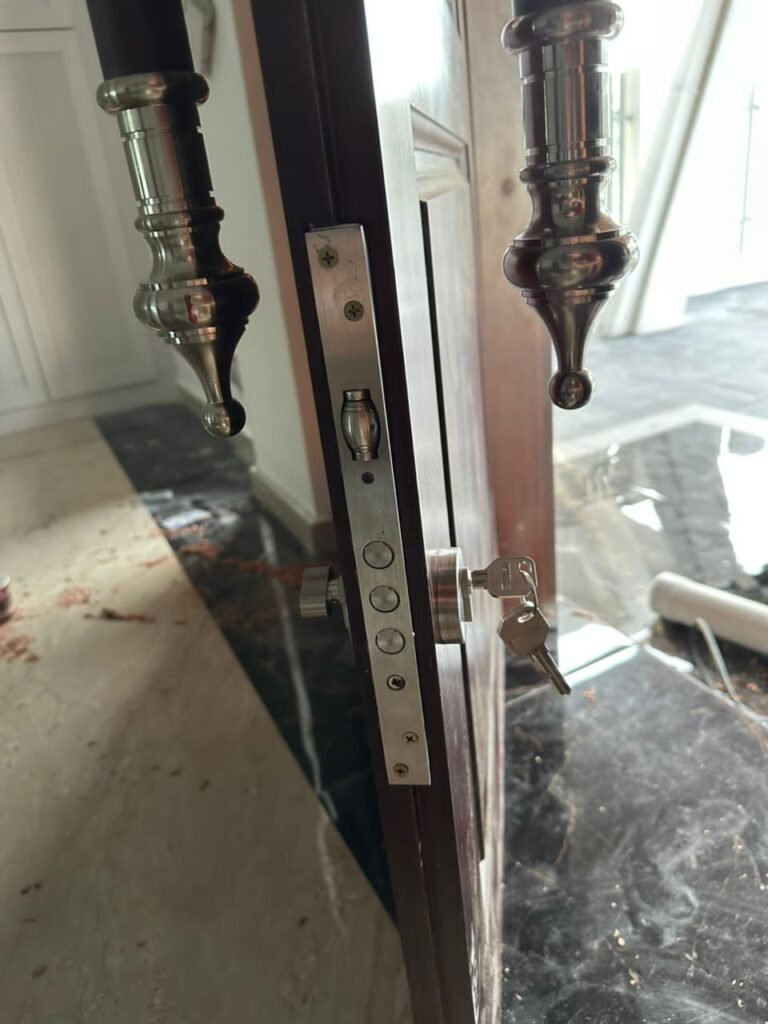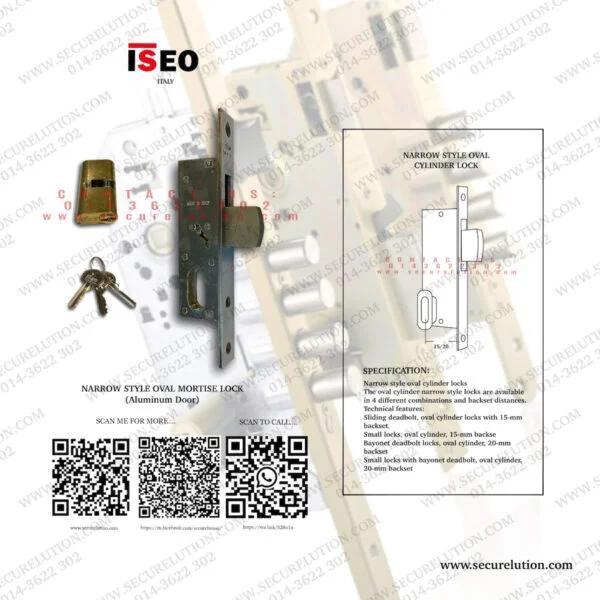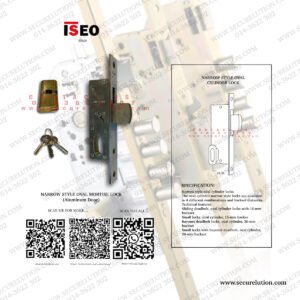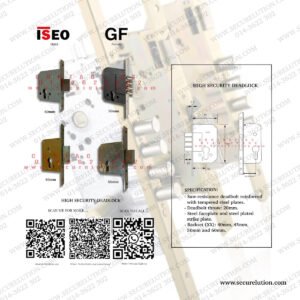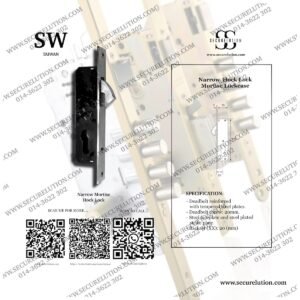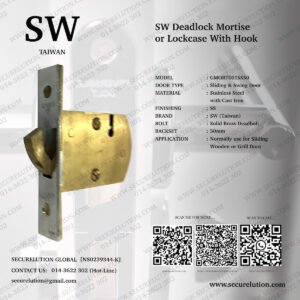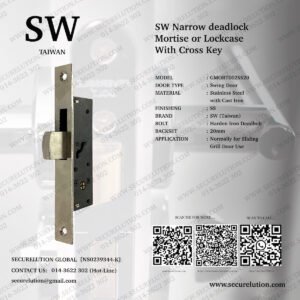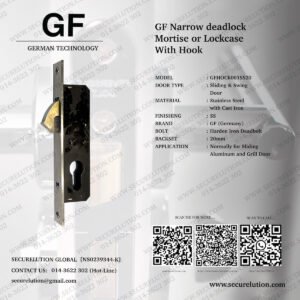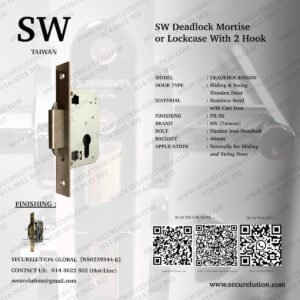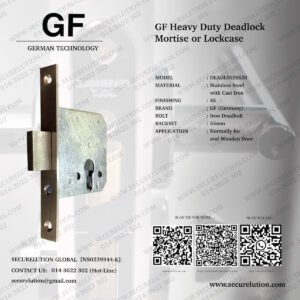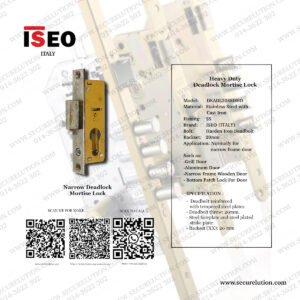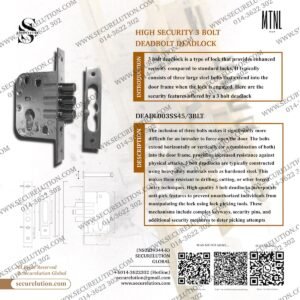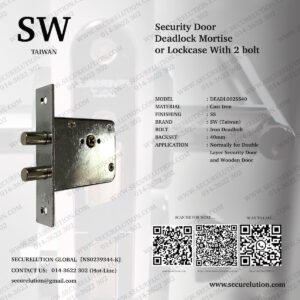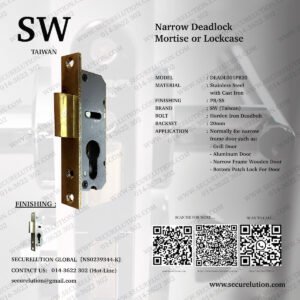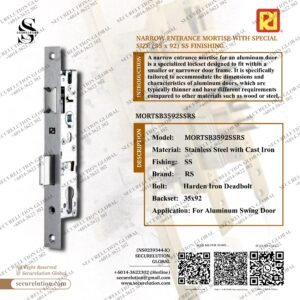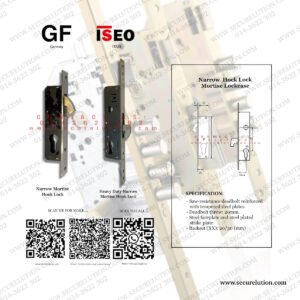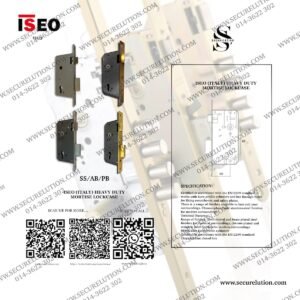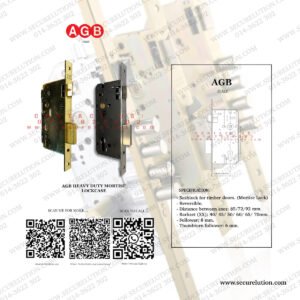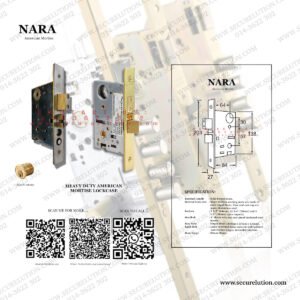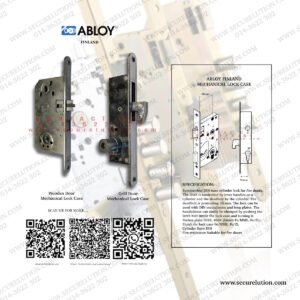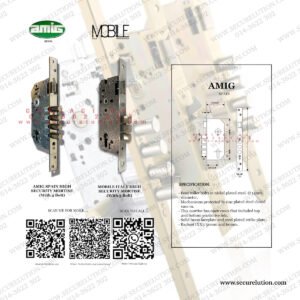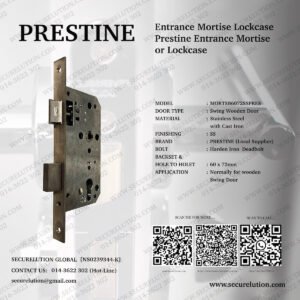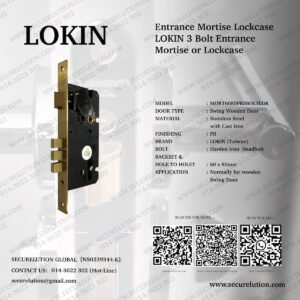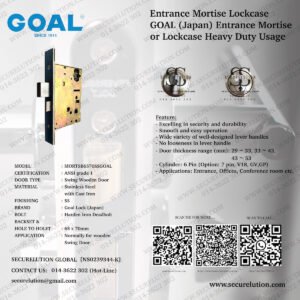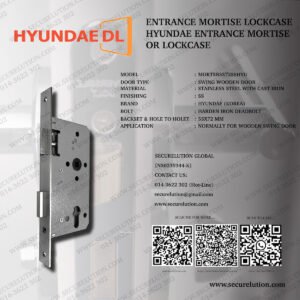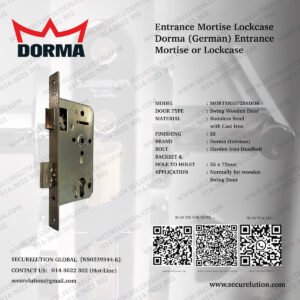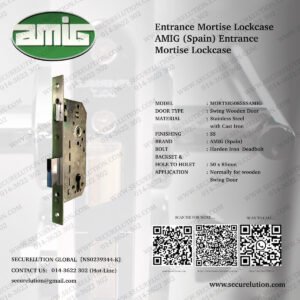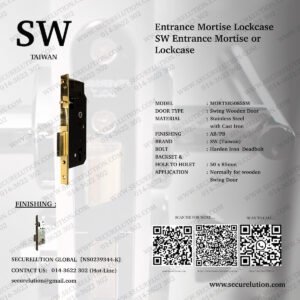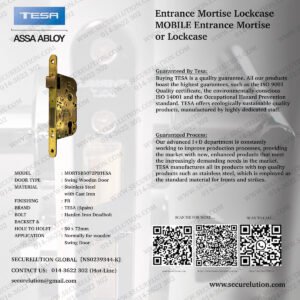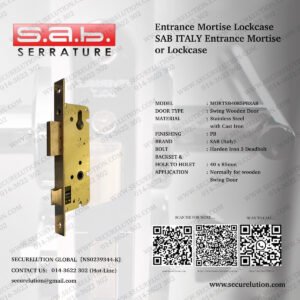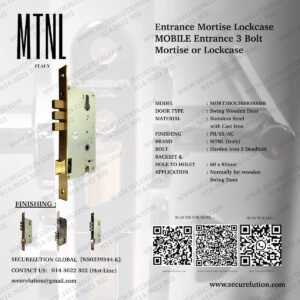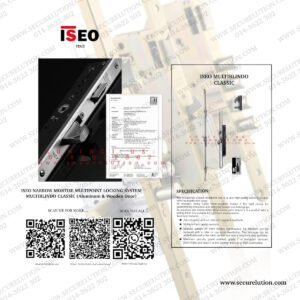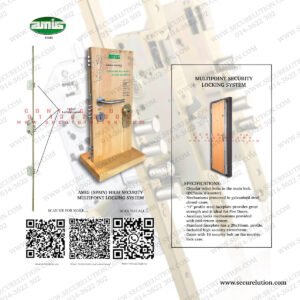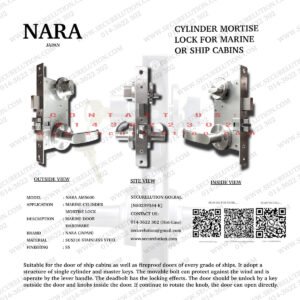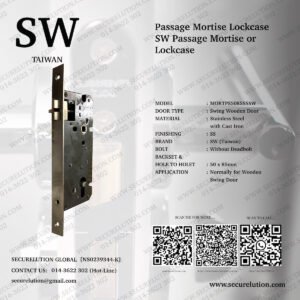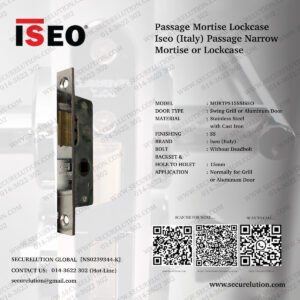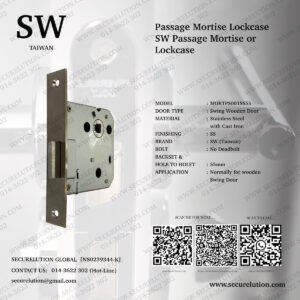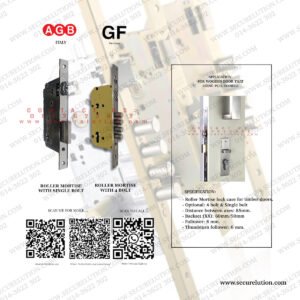Mortise Lockcase
A mortise lock is a type of lock that is installed within the body of a door, rather than being attached to the surface
One of the primary ways a mortise lock affects door security is through its robust build. The inner workings of a mortise lock are encased within the door itself, making it significantly more difficult to tamper with or force open compared to surface-mounted locks. This design reduces the risk of intruders bypassing the lock through physical manipulation or destructive methods such as prying or wrenching.
Deadlock Mortise
A heavy-duty deadlock is a high-security locking mechanism designed to provide robust protection against unauthorized entry. These types of deadlocks are engineered to withstand substantial force and attempts at tampering, making them a popular choice for securing both residential and commercial properties.
- Solid Construction: Heavy-duty deadlocks are typically constructed using durable materials such as solid steel or hardened brass. This sturdy construction adds to their resilience against physical attacks, including drilling, cutting, and prying.
- Large Bolts: Unlike standard deadlocks, heavy-duty variants often feature larger and thicker bolts. These heavy-duty bolts provide enhanced resistance against forced entry, as they are more difficult to manipulate or break through.
- Advanced Cylinder Mechanism: Many heavy-duty deadlocks are designed with advanced cylinder mechanisms, such as anti-drill and anti-pick features. These mechanisms help prevent unauthorized individuals from bypassing the lock using common tampering methods.
- High-Security Keyways: Heavy-duty deadlocks often employ high-security keyways and restricted key systems, making them less susceptible to unauthorized key duplication or manipulation. This key control feature adds an extra layer of security to the locking system.
- Impact-Resistant Strike Plates: To complement the strength of the lock itself, heavy-duty deadlocks are typically paired with reinforced strike plates. These strike plates are designed to withstand heavy impacts and attempts to kick in or force open the door.
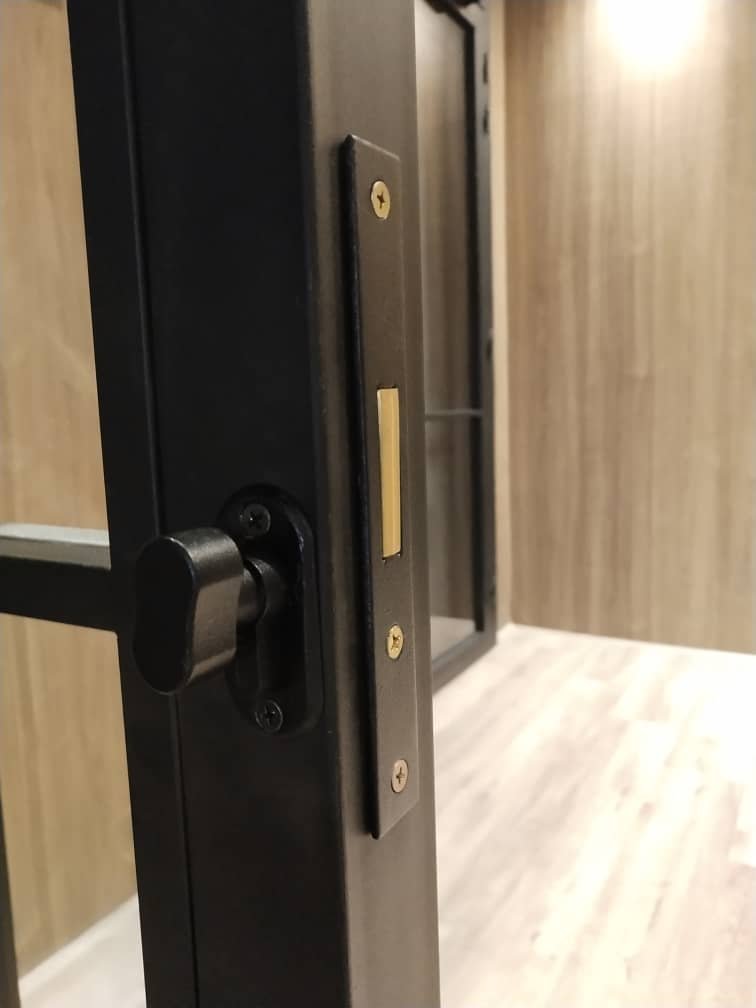
Entrance Mortise Lock
A mortise lock is a type of lock that is installed within the body of a door, rather than being attached to the surface. This particular lock design offers significant security benefits due to its construction and operation.
One of the primary ways a mortise lock affects door security is through its robust build. The inner workings of a mortise lock are encased within the door itself, making it significantly more difficult to tamper with or force open compared to surface-mounted locks. This design reduces the risk of intruders bypassing the lock through physical manipulation or destructive methods such as prying or wrenching.
Additionally, mortise locks typically feature complex internal mechanisms, such as multiple locking points and heavy-duty materials, which contribute to their high level of security. These locks are often made of durable materials like solid brass or steel, providing resistance against drilling, cutting, and other forms of forced entry.
Moreover, mortise locks offer a higher degree of key control and customization. They can be fitted with high-security keyways and restricted key systems, making it more challenging for unauthorized individuals to duplicate or manipulate keys. This level of key control adds an extra layer of security, especially in commercial or high-traffic settings where key management is crucial.
In terms of functionality, mortise locks often come with features such as deadbolts, latch bolts, and auxiliary locking mechanisms, providing multiple points of engagement to secure the door. This multi-point locking system enhances overall door security by distributing force across various locking points, making it harder for intruders to breach the door.
Furthermore, the installation of a mortise lock typically involves precise fitting and alignment within the door, ensuring that the lock operates smoothly and securely. Proper installation of a mortise lock can prevent common vulnerabilities associated with misaligned or poorly fitted locks, which can compromise door security.
Overall, the impact of a mortise lock on door security is substantial. Its robust construction, advanced internal mechanisms, key control features, and multi-point locking capabilities make it an ideal choice for enhancing the security of residential, commercial, and institutional doors. When installed and maintained properly, a mortise lock can significantly decrease the likelihood of unauthorized access and provide peace of mind for property owners and occupants.

Electrical Strikes
An electric strike is a type of door locking mechanism commonly used in access control systems. It is designed to electronically control the opening and closing of a door, offering convenience, security, and flexibility. Unlike traditional mechanical locks, electric strikes are operated and controlled by an electrical signal, allowing for remote access and integration with various security systems.
- Enhanced Access Control: Electric strikes provide a way to control access to a building or a specific area within a building. They can be integrated into access control systems, allowing authorized individuals to unlock the door using keycards, keypads, biometric scanners, or remote controls.
- Remote Operation: One of the significant advantages of electric strikes is their ability to be operated remotely. This allows for centralized control of multiple entry points, making it easier to manage and monitor access to different areas within a facility.
- Fail-Secure or Fail-Safe Modes: Electric strikes can be configured to operate in either fail-secure or fail-safe mode. In fail-secure mode, the strike remains locked in the event of a power failure, whereas in fail-safe mode, it unlocks during a power outage to facilitate emergency egress.
- Versatility: Electric strikes are compatible with a wide range of door types, including wooden, metal, and glass doors. They can be installed in conjunction with various locking devices, such as cylindrical locks, mortise locks, and rim exit devices.
- Integration with Access Control Systems: Electric strikes seamlessly integrate with access control systems, enabling features such as time-based access, audit trails, and remote monitoring. This integration enhances overall security and provides administrators with greater control over access permissions.
- Secure and Quiet Operation: Electric strikes are designed to provide secure locking while minimizing noise during operation. This makes them suitable for environments where quiet operation is desired, such as offices, hotels, and residential buildings.
ISEO & AMIG Multipoint Locking System
A multipoint locking system is a type of door locking mechanism that secures the door at multiple points along its frame. Unlike traditional single-point locks, which secure the door at the handle or knob, multipoint locks feature additional locking points, typically at the top and bottom of the door as well as at the handle level. This system provides enhanced security, improved sealing against the elements, and increased resistance to forced entry.
- Multiple Locking Points: Multipoint locks typically engage at least three points along the door frame when locked, with the potential for even more locking points in certain designs. These additional locking points distribute the force applied to the door during a break-in attempt, making it more difficult for intruders to pry the door open.
- Enhanced Security: By securing the door at multiple points, multipoint locking systems provide a higher level of security compared to traditional single-point locks. This is particularly beneficial for external doors and doors leading to vulnerable areas within a building.
- Improved Sealing and Insulation: Multipoint locks often include additional features such as compression bolts or rollers that help create a tighter seal when the door is closed. This improved sealing helps enhance the door’s resistance to drafts, water infiltration, and air leakage.
- Ease of Operation: Despite engaging at multiple points, multipoint locks are designed for ease of operation. When the key is turned or the handle is lifted, all locking points simultaneously engage or disengage, allowing for seamless locking and unlocking of the door.
- Commonly Used in uPVC and Composite Doors: Multipoint locking systems are frequently utilized in uPVC and composite doors, providing these types of doors with robust security and functionality.
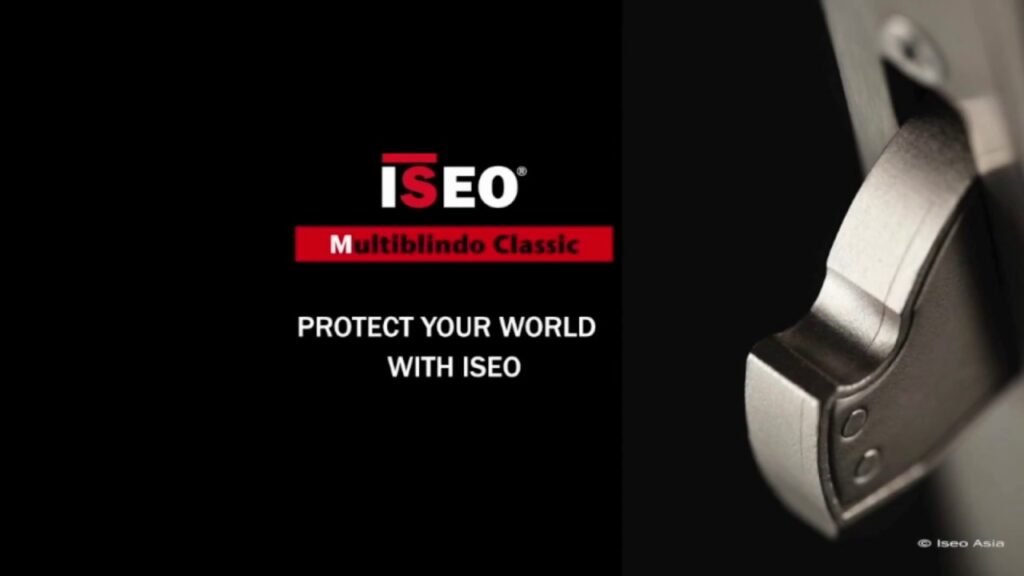
-
GOODNOTEAMIGMULTIPOINTLOCK
AMIG(Spain) High Security Multipoint Security Locking System
Nara AM5600
Marine mortise locks are specifically designed for use in maritime environments, such as on boats, ships, and other sea vessels. These locks are engineered to withstand the unique challenges posed by exposure to saltwater, high humidity, and constant motion. Key features of marine mortise locks include:
1. Corrosion Resistance: Marine mortise locks are constructed using corrosion-resistant materials, such as stainless steel or marine-grade alloys. This ensures that the lock can withstand exposure to saltwater without succumbing to rust or corrosion, which is essential in marine environments.
2. Weatherproof Seals: These locks are often equipped with weatherproof seals or gaskets to protect the internal components from water intrusion. This feature helps maintain the integrity of the locking mechanism, even in wet and salty conditions.
3. Enhanced Durability: Marine mortise locks are built to withstand the harsh conditions of marine environments, including constant motion, vibrations, and exposure to the elements. They are designed to maintain their functionality and structural integrity even under challenging circumstances.
4. Resistance to UV Degradation: Given that marine locks are often installed on the exterior of vessels, they are designed to resist UV degradation caused by prolonged exposure to sunlight. This ensures that the lock’s appearance and performance are not compromised over time.
5. Secure Locking Mechanism: Marine mortise locks feature robust locking mechanisms that provide reliable security in marine settings. Whether used for cabin doors or storage compartments on a vessel, these locks offer peace of mind in terms of securing valuable assets and ensuring the safety of occupants.
Overall, marine mortise locks are engineered to meet the demanding requirements of maritime applications, providing reliable security, durability, and resistance to the harsh marine environment.
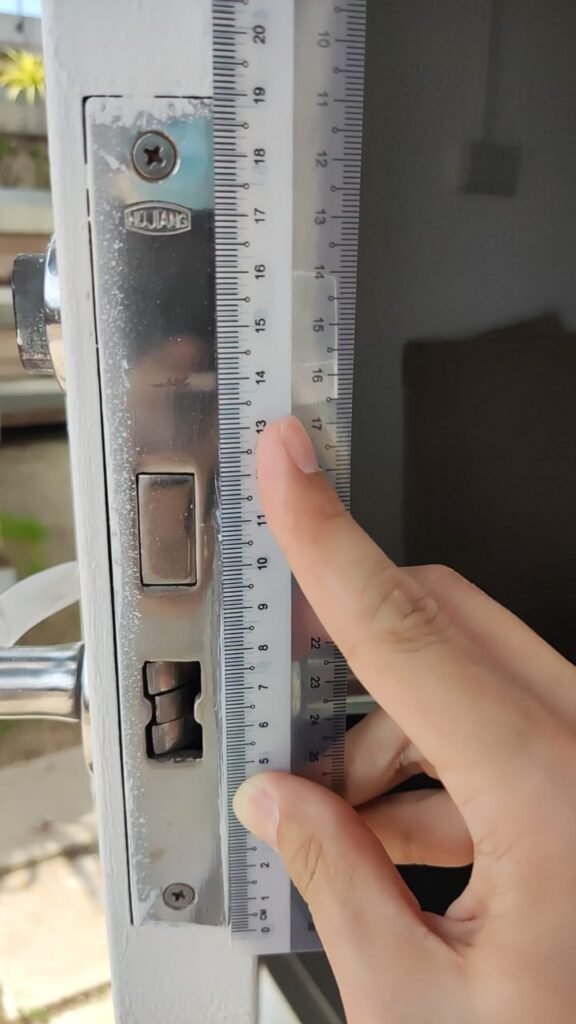
Passage Mortise
A passage function mortise lock is a specific type of lock designed for interior doors where no key or privacy functionality is required. This type of lock is commonly found in residential and commercial settings, especially in areas where there is no need for locking the door, such as hallways and closets.
1. Non-Locking Functionality: Unlike traditional locks, a passage function mortise lock does not have a locking mechanism. It is designed to provide simple latching and unlatching to allow free access through the door.
2. Ease of Use: The absence of key-operated locking mechanisms makes passage function mortise locks easy to operate. They are suitable for areas where quick and unrestricted access is needed, such as common areas and hallways.
3. Latching Mechanism: The mortise lock contains a latch that keeps the door closed but does not provide any form of security or privacy. This latching mechanism allows the door to be easily pushed open from either side without the need for a key.
4. Durable Construction: Passage function mortise locks are typically constructed with durability in mind, featuring sturdy materials such as solid brass or steel to ensure long-lasting performance even with frequent use.

Roller Mortise
Roller mortise locks, also known as roller latch mortise locks, are a type of door lock mechanism that utilizes a spring-loaded roller latch to secure doors. These locks are commonly used in commercial settings, especially in areas where a high level of traffic necessitates a durable and efficient locking solution. Roller mortise locks offer several key features that make them well-suited for commercial and industrial applications:
1. Roller Latch Mechanism: The primary component of a roller mortise lock is the spring-loaded roller latch mechanism. This roller latch retracts into the lock case when the door is closed and then extends to engage with the strike plate when the door is fully closed, providing secure and reliable latching.
2. Smooth and Quiet Operation: Roller mortise locks are designed to provide smooth and quiet operation, making them ideal for interior doors in commercial buildings. The roller latch mechanism promotes effortless opening and closing of doors while minimizing noise.
3. Durable Construction: These locks are built to withstand the rigors of high-traffic environments. They are often constructed using heavy-duty materials such as steel or solid brass, ensuring longevity and robust performance in demanding settings.
4. Suitable for Commercial Interiors: Roller mortise locks are commonly used on interior doors in commercial buildings, including offices, retail spaces, and institutional settings. Their durability and smooth operation make them well-suited for areas with frequent foot traffic.
5. Versatility: Roller mortise locks are compatible with a variety of door materials and configurations, accommodating both wood and metal doors. They can also be configured for left-hand or right-hand door orientations, providing flexibility in installation.
6. Security and Convenience: While roller mortise locks are primarily designed for internal doors where security is a concern but key access is not necessary, they provide a reliable means of keeping doors closed and secure while allowing for easy passage when unlatched.
